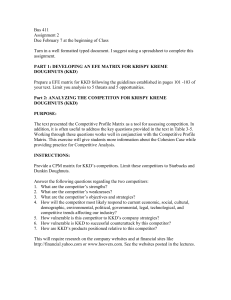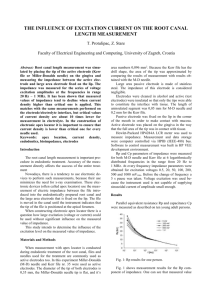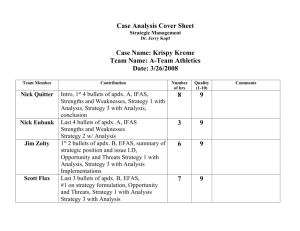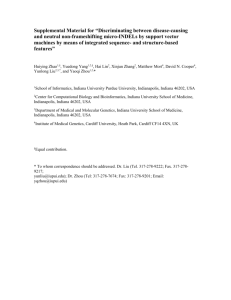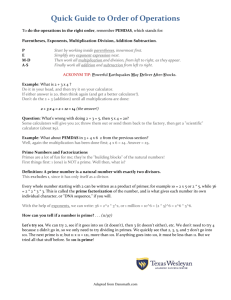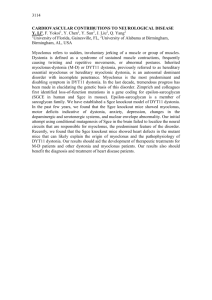KKD Case Analysis: Strategy & Competition
advertisement
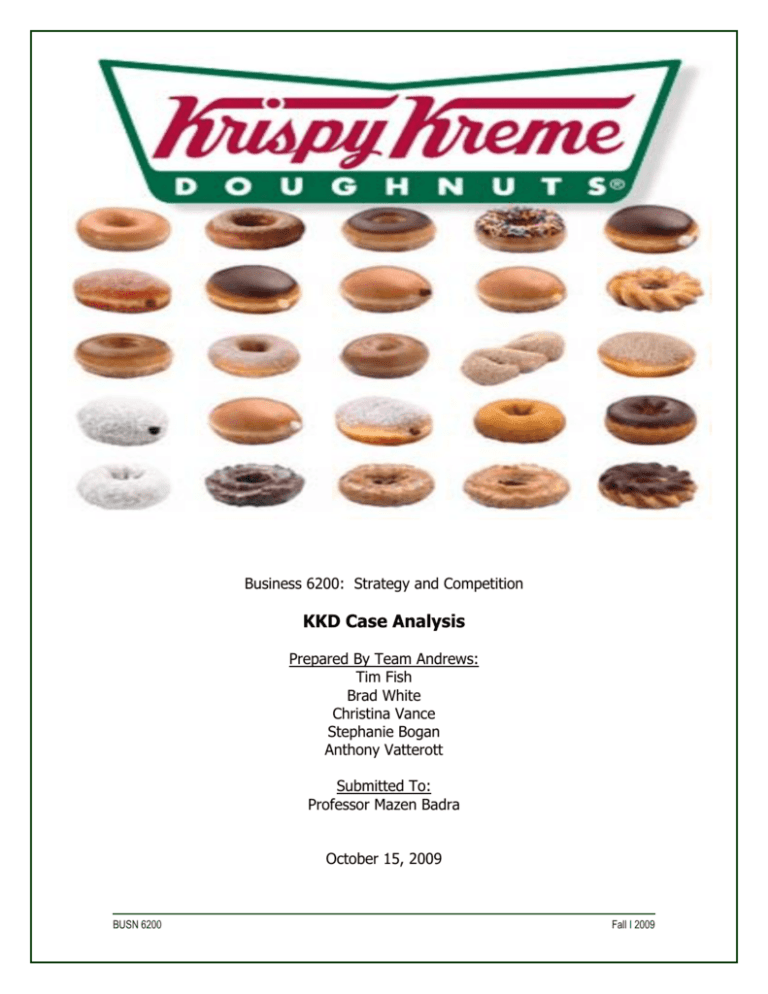
Team Andres KKD Case Analysis Business 6200: Strategy and Competition KKD Case Analysis Prepared By Team Andrews: Tim Fish Brad White Christina Vance Stephanie Bogan Anthony Vatterott Submitted To: Professor Mazen Badra October 15, 2009 BUSN 6200 Fall I 2009 Team Andrews KKD Case Analysis TABLE OF CONTENTS I. Introduction .................................................................... 1 II. SWOT Analysis ................................................................ 2 III. Industry Analysis ............................................................. 5 IV. Recommended Strategy ................................................. 10 List of Figures A. Figure 1: Porters Five Forces Model...................................... 6 B. Figure 2: Business Strategies ............................................... 9 BUSN 6200 i Fall I 2009 Team Andrews KKD Case Analysis I. INTRODUCTION Krispy Kreme Doughnuts, Inc. (KKD) is a unique brand offering doughnuts, beverages, collectibles, and franchise opportunities. Pioneered as a small bakery in Winston Salem, North Carolina on July 13, 1937; KKD has evolved into a publicly traded firm boasting 395 retail stores and over four million dollars in sales (second quarter fiscal year 2008). So, why did the firm’s president and chief executive officer Daryl Brewster (pictured right) say “After several quarters of progress on our turnaround, second quarter results [fiscal year 2008] did not meet our expectations.”? His statement is largely due to the significant losses the firm has experienced since fiscal year 2005. KKD’s total revenues sunk from the five million dollar range at the close of fiscal year 2006 to the four million dollar range at the close of fiscal year 2007. The sharp decline in sales is accompanied by a system wide decrease in retail stores. KKD’s retail operation shrunk from 433 stores at the close of fiscal year 2005 to 395 stores at the close of fiscal year 2007. Nonetheless, the quick-service restaurant (QSR) industry that KKD competes in has experienced “everincreasing” growth during the last two decades, and the trend is expected to continue as a greater percentage of Americans work more and enjoy less home cooked meals. KKD executives, namely the aforementioned president and chief executive officer, believe the key to improving the firm’s performance and capitalizing on industry growth is to increase the percentage of stores operated by franchisees. Is this the best strategy for the firm to pursue? To answer this question we must identify where the QSR industry is positioned according to the industry life cycle framework; assess the attractiveness of the QSR industry based on Porter’s Five Forces Model, and reveal KKD’s strengths, weaknesses, opportunities, and threats. The information presented will determine if KKD should continue with their current strategy of increasing franchisees or an alternative strategy. We will begin with an assessment of KKD’s strengths, weaknesses, opportunities, and threats. 1. BUSN 6200 1 Fall I 2009 Team Andrews KKD Case Analysis II. SWOT ANALYSIS The following SWOT analysis is intended to examine KKD’s internal strengths and weaknesses and link them to external opportunities and threats with the aim of selecting a strategy to pursue. STRENGTHS As a global firm, KKD has established itself as a consumer brand with a consistent customer base in the United States and abroad. KKD has branched into grocery and convenience stores so accessibility to the doughnut brand is readily available. The company sells over 20 different varieties of doughnuts and other menu items include coffee and bakery items. They also have a collectable memorabilia for sell such as mugs, hats, and toys. KKD is a vertically integrated company with three business units: company store operations, franchise operations, and KK supply chain operations. Their supply chain manufacturing uses an accelerated approach that allows for high volume of production and output in a cost effective manner. They use specialized doughnut-making equipment and specific doughnut mixes that each store, whether franchise or company owned, are required to purchase. This gives each store the capacity to produce from 4,000 to 10,000 doughnuts daily. KKD offers a product that is second to none, with regards to taste, freshness, and the finest ingredients. The original glazed doughnut is their signature doughnut. It remains the top seller amongst other pastries in its category. They have a loyal customer base in the U.S. market. That said, KKD continues to introduce their brand to the international markets such as Europe, Australia, and Asia. Leadership is a strength for KKD over the last few years. After its vamping increase in sales in the early 2000s KKD went through a series of managers from 2005 - 2007 to find a way to make the company profitable again. The door has stopped rotating as the business strategy is fundamentally more stable in today’s environment. WEAKNESSES According to Porter’s framework, weaknesses refer to any limitations that a firm faces in developing or implementing a strategy. Weaknesses should be considered from the customer and the corporate perspective. KKD has the following weaknesses relative to the QSR industry environment: 1. Only 395 KKD stores compared to 7,000 Dunkin' Donuts and 12,000 BUSN 6200 2 Fall I 2009 Team Andrews KKD Case Analysis Starbucks Limited amount of "healthy" menu selections Limited “non-breakfast” menu items Poor management/financial practices hurt reputation & stock prices until 01/2007 Limited amount of non-snack food items International differences/preferences OPPORTUNITIES International expansion promises better returns than to expand domestically. Asia and the Middle East both offer KKD favorable population demographics, relatively high levels of consumer sweet goods consumption and the popularity of Western brands in these markets. During the past two decades, an ever-increasing percentage of U.S. food dollars has gone to eating out. With a greater percentage of Americans working, there has been less time available for at-home food preparation. KKD believes this trend along with growth in two-income households will increase snack-food consumption and further growth of doughnut sales. Most internationally located stores purchase their ingredients from local merchants rather than KK Supply Chain. If KKD can find a cost effective way to provide these ingredients, they can capitalize on supply chain efficiencies to make a profit. The introduction of a new beverage program is expected to be implemented in the next few months. This program, if executed successfully, will allow for healthy competition in the hot drinks market and a challenge to both Starbucks and McDonalds offerings in the hot beverages market. THREATS Over the past two decades competition in the fast-food market has increased. With both spouses working in today’s environment less and less time in being spent in the household kitchen. It is more common, and convenient, to grab a quick meal than the traditional home cooked meal. Therefore, it comes with no surprise that substitute products enter the casual-dining sector to gain market share of the fast-food chains. In the doughnut and pastry shop industry this is no different. Price wars are generated in attempts to take away revenue from other restaurants and sustain growth. Therefore, KKD must constant be aware of substitute products from many different areas of the market place. Such substitutes demanded today include healthier menu items include zero trans fats in all products. Going organic or using 100% natural ingredient items to favor 1. BUSN 6200 3 Fall I 2009 Team Andrews KKD Case Analysis comparable products. Therefore, companies in this industry must remain focused on substitute products from many different areas of the marketplace. 1. BUSN 6200 4 Fall I 2009 Team Andrews KKD Case Analysis III. INDUSTRY ANALYSIS In this section we will determine where the QSR industry is positioned according to the industry life cycle framework and assess the attractiveness of the QSR industry based on Porter’s five forces model. Industry Life Cycle: Business industries are not static. Generally, industries evolve from an introduction stage to a decline stage experiencing growth and maturity along the way. It is important to understand the evolution of the QSR industry that KKD competes in to accurately assess the strengths, weaknesses, opportunities, and threats impending or enabling the firm’s growth. The introduction stage is dominated by the marketing of an innovation for the first time. Competition is minimal (if any) and returns are negative as most present in the market must recover R&D, marketing, and manufacturing costs. The growth stage is characterized by high profits, product reliability, and competition. During this stage firms will begin to differentiate based on value and quality. The maturity stage boasts high sales accompanied by significant price pressures. Profit margins are often compromised as consumers perceive the firm’s products as homogeneous positioning price as the key buying criteria. The decline stage is marked by sinking profits and many firms will decide to remain in the industry or exit and utilize their resources on more profitable business segments. Stock share prices in the QSR industry are on the rise following a recent drop caused by aggressive price cuts by industry leaders, namely McDonald’s and Burger King. Stable same-store sales growth and positive operating conditions have also contributed to the surge in casual dining industry stocks. The casual dining sector is expected to gain share from fast food chains as more mature and financially elite consumers dine in full service restaurants. Many competitors in the QSR industry are lowering prices and slowing expansion in the overstored fast food market to focus on creating “healthy” menu items. Based on these key factors, we believe the QSR industry is in the maturity stage of the industry life cycle. This is due to a low level of innovation, fluctuating profit margins, and global expansion. 1. BUSN 6200 5 Fall I 2009 Team Andrews KKD Case Analysis PORTER’S FIVE FORCES MODEL Porter’s Five Forces Model is a framework for industry analysis and business strategy development pioneered by Michael E. Porter of the Harvard Business School in 1980. The framework is rooted in Industrial Organization and strives to identify the mitigating factors related to five forces that determine the competitive intensity and overall attractiveness of an industry. In this section we apply the framework to identify KKD’s competitive position within the QSR industry. Suppliers Minimal suppliers Many buyers Highly accessible substitute inputs Potential Entrants High barriers to entry Economies of Scale Low Switching Cost Degree of Rivalry Many competitors Moderate differentiation Buyers High concentration of buyers High number of suppliers Low switching cost Variety of substitutes Substitutes Direct subs Indirect subs Low switching costs Figure 1: Porter's Five Forces Model 1. BUSN 6200 6 Fall I 2009 Team Andrews KKD Case Analysis Potential Entrants During the maturity stage of the industry life cycle, the threat of potential entrants is minimal. Majority of the firms present in the industry have developed economies of scale providing a cost advantage over new entrants. KKD is positioned as follows in terms of potential entrants: Absolute cost advantage-KKD and KK Supply Chain manufacture their own doughnut-making equipment and produce doughnut mixes Economies of Scale-entirely automated, the doughnut making process is very efficient Access to distribution-KKD sells directly to the customer via KKD stores with counters and drive-through windows. As well as, off-premises through grocery and convenience stores Brand identity-KKD is known for their "Hot Doughnuts Now" signs as well as "doughnut-making theaters" where customers can watch the doughnut making process through glass windows Bargaining Power of Suppliers The bargaining power of both KKD suppliers and the KK supply chain for franchisees is significant. Both franchise stores and company stores are required to purchase all supplies from KK Supply Chain which provides all supplies including foodstuffs, equipment, signage, and uniforms. The KK Supply Chain unit buys and processes all ingredients used in the doughnut mixes and manufactures the doughnut-making equipment that all stores are required to purchase. KK Supply Chain also includes the coffee roasting operations and also ships all food ingredients, juices, display cases, uniforms, and other items to KKD locations on a weekly basis by common carrier. This allows for maximized leverage when negotiating costs for staples such as potato flour and sugar, by volume, and gives the supplier added bargaining power. This also allows KKD to maintain control over the price of goods supplied to the vendors, keeping operations costs lower for the franchisee while still allowing a healthy profit margin. KKD also manages contracts to outsource the making of donuts for grocery distribution, and the reach of KKD allows for a price-making position. If those suppliers do not deliver goods on time, KKD cannot supply its company and franchise stores and they would lose valuable revenue. Bargaining Power of Buyers The QSR industry offers many substitutes for KKD products and the cost of switching is low. In fact many consumers prefer diversity in their diet and with an increasingly health conscious market place – the consumption of “sweets” like doughnuts is limited. Combine this with the high promotion budgets of market 1. BUSN 6200 7 Fall I 2009 Team Andrews KKD Case Analysis leaders like McDonald’s, Burger King, and Dunkin Donuts – consumers are enticed on a daily basis to exercise their right to switch. Thus, buyers have significant bargaining power. Threat of Substitutes Over the past two decades competition in the fast-food market has been everexpanding. With both spouses working in today’s environment less and less time is being spent in the household kitchen. It is more common, and convenient, to grab a quick meal than the traditional home cooked meal. Therefore, it comes with no surprise that substitute products enter the casual-dining sector to gain market share of the fast-food chains. In the doughnut and pastry shop industry this is no different. Price wars are generated in attempts to take away revenue from other restaurants and sustain growth. Therefore, KKD must constant be aware of substitute products from many different areas of the market place. Such substitutes demanded today include healthier menu items include zero trans fats in all products. Going organic or using 100% natural ingredient items to favor comparable products. Therefore, companies in this industry must remain focused on substitute products from many different areas of the marketplace. Degree of Rivalry The QSR industry boasts a variety of firms/products including KKD’s indirect competitors McDonalds and Burger King. KKD’s direct competitors are Dunkin’ Donuts, Starbucks Corporation, and Tim Hortons. The large number of direct and indirect competitors in the QSR industry signifies a significant degree of rivalry. KKD strives to differentiate its product offerings to remain competitive. 1. BUSN 6200 8 Fall I 2009 Team Andrews KKD Case Analysis V. RECOMMENDED STRATEGY Team Andrews recommends KKD focus on business level strategies to remain competitive within the QSR industry and increase profitability. Porter’s Five Forces Model, as discussed in the previous section, provides a foundational matrix for identifying how firms can achieve advantage within an industry. The matrix identifies two primary sources by which firms can achieve an advantage: (1) cost and (2) uniqueness. The matrix appears below in figure 2: Competitive Scope Broad Target Narrow Target Competitive Advantage Cost Uniqueness Cost Leadership Differentiation Focused Low Cost Focused Differentiation Figure 2: Adapted from Strategic Management for the Capstone Business Simulation and Comp XM: Analysis and Assessment Considering that KKD serves a broad (international) target market the firm should focus on cost leadership and differentiation. Cost leadership is based on high volume sales of low margin products/services. To that end, KKD must focus on increasing their sales – across all three sectors of the business, not just franchisees. This should be done by first identifying and adhering to each segment of their target market’s key buying criteria at the lowest possible cost to the firm. Then KKD should decrease their prices and adjust marketing/sales budgets and R&D expenditures to create a significant and sustainable cost gap, relative to competitors, by leveraging economies of scale (complete automation of the doughnut making process, added capacity, and TQM). KKD does manufacture and sell some high margin products/services across all three sectors. We recommend in addition to focusing on cost leadership with their low margin products/services that KKD strive to further differentiate their high margin products/services. This may be achieved through creative branding, improving the customer experience, introducing a new product, or entering exclusive partnerships with suppliers/distributors. We believe that if KKD executives embrace the cost leadership – differentiation business level strategy the firm will see increased revenues, retail operations, and interest in the brand. 1. BUSN 6200 9 Fall I 2009
